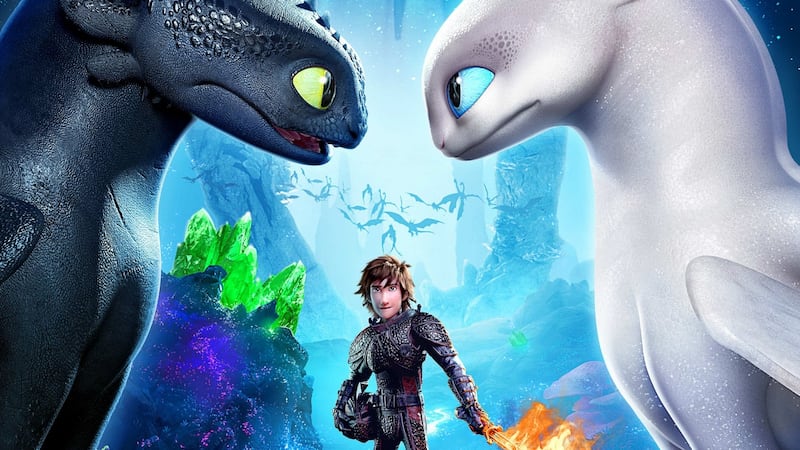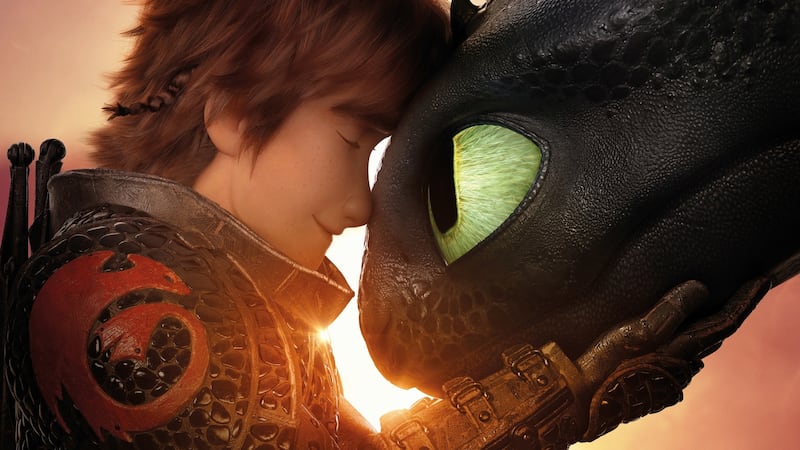When DreamWorks unveiled 20 minutes of footage from the concluding part of the How To Train Your Dragon trilogy – How to Train Your Dragon: The Hidden World – at the Annecy Animation Film Festival last June, many younger animators, who had grown up watching the sequence, were reduced to tears, if not actual bawling.
It’s a strange feeling, says franchise director Dean DeBlois, who, in the new film’s dragon courtship scene, has crafted one of animation’s loveliest sequences.
“It’s amazing because I still think of myself as not having achieved my goals,” says DeBlois. “I look at Steven Spielberg and James Cameron and Ridley Scott, my heroes, and they’re still out there making films. I aspire to do what they do.
"It's grown over the last decade but within the fanbase, there are a lot of people who decided that they wanted to do animation in college or they wanted to work for DreamWorks watching How to Train Your Dragon. I think about the films that propelled me into the business, like George Lucas's original Star Wars trilogy – and I've been lucky enough to meet George – so to meet people who are were propelled into this business by the How to Train Your Dragon films is really cool. It makes you part of a bigger cycle."
Commercially successful
With a global box office haul of nearly $500 million (€438 million) and a Rotten Tomato rating of 98 per cent, 2010's How to Train Your Dragon was one of the most critically and commercially successful animated movies of the decade. The Golden Globe-winning 2014 sequel repeated the trick with similarly positive notices and a $621.5 million (€544.4 million) take.

It might not have happened that way. At the moment when DeBlois joined the project, How to Train Your Dragon was a "troubled production". Between Shrek sequels, its parent studio, DreamWorks Animation, was presiding over such underperforming fare as Monsters vs Aliens and Megamind.
The studio had hired Pete Hastings, the director of 2003's The Country Bears, to direct an adaptation of Cressida Cowell's 2003 children's book, How to Train Your Dragon, but when early footage skewed towards younger viewers, he was replaced by Lilo & Stich film-makers Chris Sanders and DeBlois.
Among several innovations the team brought to the table was Astrid (voiced by America Ferrera), an action heroine and a love interest for the main character, Hiccup (Jay Baruchel).
“The original adaptation was quite faithful to Cressida Cowell’s books so they were trying to tell the story of the first book which treats dragons as domesticated creatures raised by Vikings,” recalls DeBlois.
“They had a symbiotic relationship like cowboys and horses and at the end of that book there was a hostile dragon that comes along and Hiccup, the runt Viking, with his runt dragon, take it on. We departed from that narrative in order to tell a story that was a broader fantasy adventure. So Hiccup became the first Viking to befriend a dragon and their bond ended an age-old war between dragons and Vikings.
“And we thought if he is going to befriend a dragon it should be something that’s built into the folklore of the Vikings. So we took Toothless, who was a talking, dog-sized dragon from the book, and reinvented them as a large Night Fury that Hiccup would be able to ride.”
Realistic aesthetic
DeBlois also established a realistic aesthetic. A frequent collaborator with Reykjavik alt-rockers Sigur Rós – he directed the band's 2007 documentary, Heima, and Jonsi's 2010 acoustic film, Go Quiet – the veteran animator visited Icelandic locations, he hired director of photography Roger Deakins as a visual consultant, and he and his team studied animal behaviour to get fan favourite Toothless just right.
"From the start we wanted to depart from the convention of talking dragons and treat them like wild animals that we know," explains DeBlois. "It was important to suggest that the How to Train Your Dragon storyline happened in our own history, that there was a moment in which dragons went away, and that was the mystery of the film. So for every one of our dragons there's a dominant animal, whether it's a walrus or a parrot. In the case of Toothless he's very feline. He's a black panther mixed with a salamander. With Toothless it was very much our intention that the audience would be able to recognise their own pets' behaviour. So we just studied cat attributes and dog mannerisms. He can be fierce and hostile and yet very cute and cuddly."

DeBlois was born in Aylmer, Quebec, in 1970. Growing up he frequented a smoke store in a local strip mall that allowed the comic-mad youngster to read whatever was on the shelf for free. He was especially fond of the Conan the Barbarian series, but with no obvious path into the industry, he enrolled instead in Sheridan College's three-year classical animation programme in Ontario and took a job as an assistant animator and layout artist for Hinton Animation Studios/Lacewood Productions, the home imprint of 1980s cult classic, The Raccoons.
In 1990, he relocated to Dublin to work at Sullivan Bluth Studios, the production company founded by former Disney animators in 1979.
"It was a strange time," he recalls. "It's interesting, because certainly the people who followed Don Bluth out of Disney and eventually to Ireland were inspired by the work that was done on The Secret of NIMH that was so promising. That was the declaration that they were going back to the quality of films like Sleeping Beauty. They were very ambitious at a time when Disney felt a little apathetic and were making films like Oliver and Company.
“I arrived in 1990 and I was there until 1994 and a lot of the studio’s greater artistic achievements are behind them. They were making films that were less confident. So I was surrounded by people who were so talented and so passionate. People who were putting in nights and weekends and delaying holidays. But I was also seeing the shortcomings in storytelling. That was very formative.”
Expensive endeavour
In 1994, DeBlois relocated to Los Angeles to begin work for Walt Disney Feature Animation as a storyboard artist. He began as head of story on Mulan, the project that introduced him to writer-director Sanders. The pair re-teamed to create Lilo & Stitch in 2002 and again to fashion How to Train Your Dragon in 2008. Lilo & Stitch, which spawned a four-season TV spin-off, is surely one of the projects that can't be remade as a live action feature.
“Oh, they’re doing it,” says DeBlois. “I mean, I get it. Film-making is a very expensive endeavour and marketing films is just as expensive as making the films themselves. So it’s a risky business a studio has to be really healthy in order to risk the amount of money to make any film. So they depend on successes, they depend on sure things.
“But my feeling is that it’s a bit lazy. Crafting the story and working with it and fighting with it and getting it right is a real challenge. It feels a bit like cheating to come in and to take a film that’s already critically and commercially successful. And also that the implication that they’re making it better. That’s what I dislike about it. It seems to be saying that animation is a lesser art form.”
DeBlois is the opposite of precious about the new Chinese incarnation of Lilo & Stitch. Beginning in 2017, Stitch & Ai is the franchise's third television series, following on from the Disney Channel's Lilo & Stitch: The Series and the Japanese Stitch! anime series.
"I love that animation has a timeless quality and that it has such a broad reach," says the Canadian film-maker. "I was so inspired by Hayao Miyazaki. Lilo & Stitch has a lot of Miyazaki-inspired elements, especially from My Neighbour Totoro. That Hiccup flies on the back of Toothless with these early da Vinci-like mechanics felt to me like a Miyazaki-inspired idea. So I was really tickled to go to Japan and see how integrated Stitch was into Japanese culture. Everywhere we went and it was joy to see how he had been embraced. When I got to meet Miyazaki, I presented him with a watercolour drawing of Stitch. And he said: 'Oh, this character I know'."
How to Train Your Dragon: The Hidden World opens February 1st




















